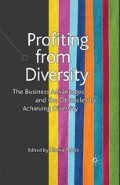Abstract
Advertising creatives are at the sharp end of creativity. The people who design and develop new advertising (the so-called creatives) are usually talented artists, musicians or wordsmiths who have found a commercial outlet for their talents — it has been said that advertising copywriters would sell their souls for a potted message: the ability to convey a message in a few words, or a single image, or a few bars of music is at the root of all advertising success.
Access this chapter
Tax calculation will be finalised at checkout
Purchases are for personal use only
Preview
Unable to display preview. Download preview PDF.
References
Bartlett, D. and Payne, S. (1997). ‘Grounded Theory — Its Basis, Rationale and Procedures’. In Understanding Social Research; Perspectives on Methodology and Practice. Eds. McKenzie, G., Powell, J., and Usher, R. (London: Falmer Press).
Corbin, J. and Strauss, A. (1990). ‘Grounded Theory Research: Procedures, Canons and Evaluative Criteria’, Qualitative Sociology, 13, 1, 3–21.
Daft, R.L. (1998). Organisation Theory and Design, Sixth Edition (Ohio: South Western College Publishing).
Hatch, M.J. (1997). Organisation Theory — Modern Symbolic and Postmodern Perspectives. (Oxford: University Press).
Hellreigel, D. and Slocum, J.W. Jr. (1988). Management, Fifth Edition (London: Addison-Wesley).
Hochschild, A.R. (2003). The Managed Heart: Commercialisation of Human Feeling (Berkeley: University of California Press).
Hodge, B.J. and Anthony, W.P. (1991). Organisation Theory — A Strategic Approach, Fourth Edition (London: Allyn and Bacon).
Reitz, H.J. (1977). Behavior in Organisations (Homewood, IL: Richard D. Irwin Inc.).
Ruekert, Robert W. and Walker, Orville C. Jr. (1987). ‘Marketing’s Interaction with Other Functional Units: A Conceptual Framework and Empirical Evidence’, Journal of Marketing, 51, January, 1–19.
Editor information
Editors and Affiliations
Copyright information
© 2010 Jim Blythe
About this chapter
Cite this chapter
Blythe, J. (2010). Barriers to Diversity: The Case of Advertising Creatives. In: Moss, G. (eds) Profiting from Diversity. Palgrave Macmillan, London. https://doi.org/10.1057/9780230273887_13
Download citation
DOI: https://doi.org/10.1057/9780230273887_13
Publisher Name: Palgrave Macmillan, London
Print ISBN: 978-1-349-35436-8
Online ISBN: 978-0-230-27388-7
eBook Packages: Palgrave Business & Management CollectionBusiness and Management (R0)

